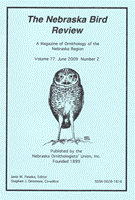Nebraska Ornithologists' Union

Nebraska Bird Review
Date of this Version
3-2022
Document Type
Article
Citation
The Nebraska Bird Review Volume 90 Number 1, March 2022, pp. 2-17
Abstract
After compiling and reviewing the observations reported to NEBIRDS, various Facebook groups, and eBird, I reiterate my leadoff comments from last winter: the increasing numbers of observers taking time to report turned up some fascinating trends. Those cited as well as those not cited, all contributed to the firmness of the database that allows better-supported conclusions to be drawn than from our past reliance all too often on anecdotal supposition. Continuing a trend pointed out last winter were the many records of species north and west of their expected winter ranges. As I suggested last winter, “it is tempting to conclude that this phenomenon is a consequence of warmer temperatures positively affecting the food supply, although local fluctuations, especially related to water conditions, and the extremely cold late winter may have had effects not yet obvious”. An example of the latter may have been the record low count of Common Mergansers at Harlan County Reservoir in Dec and the apparently related paucity of Bald Eagles; it was suggested that the extreme cold weather in Feb 2021 reduced the food supply needed to support large numbers of mergansers in 2021-2022. Species north and west of expected winter ranges might be explained by milder temperatures most of the winter. Such records were exemplified by Sandhill Cranes wintering in good numbers for a second consecutive year, a remarkable 24 Killdeer below Lake Ogallala accompanied by no less than a Dunlin, an American Woodcock far westerly in Garden Co, almost unprecedented Say’s Phoebes in Dec and Jan in Scotts Bluff and Sioux Cos, rare wintering Gray Catbirds and Northern Mockingbirds, the 5th Feb record of Field Sparrow, record numbers (151 in all!) of Fox Sparrows in the east, the 2nd Dec Nashville Warbler, two unexpected Pine Warblers, and three winter records of Yellow-rumped (Audubon’s) Warbler, where the previous total of winter records from all years had been only seven. Distributional observations are important to note and are often indicative of incipient range expansions. Examples this winter were westerly records of Barred Owl in Furnas Co, apparent first county record Red-bellied Woodpecker in Grant Co, a first Pileated Woodpecker in the Republican River Valley, and apparent first county record Northern Cardinal in Grant Co.
Included in
Ornithology Commons, Population Biology Commons, Poultry or Avian Science Commons, Zoology Commons


Comments
Published by the Nebraska Ornithologists’ Union, Inc.